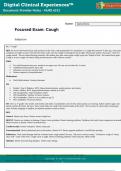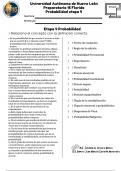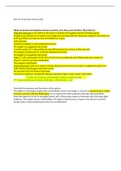Property Law Answer Structure (No plagiarism or AI)
Co-ownership of land (Express Trust)
Where land is conveyed to co-owners who are of full age, they will be joint
tenants, and there can only be four of them at most (S (34)(2) Law of Property
Act (LPA) 1925).
❖ Legal ownership
Maximum of four legal owners may be listed on the title. Usually, it is the
first four people listed in the sale agreement. There cannot be a tenancy in
common of a legal title to land (S1(6) LPA 1925), therefore there is only joint
tenants at law.
❖ Equitable ownership
In determining who owns the property, equitable ownership is what matters
most. The general rule is that equity follows the law (Stack v Dowden (2007)).
However, unequal contribution to the purchase price will result in the
assumption of a TIC (Bull v Bull (1953)). This assumption can be rebutted by
express conveyance to the parties as JTs. They will then be JTs in equity as
this will prevail over the previous assumption (Goodman v Gallant (1986), Roy
v Roy (1991)).
When the land is held by JTs, S36(2) LPA 1925 mandates that it be held
on trust, which is now defined as a trust of land subject to the Trusts of Land
and Appointment of Trustees Act (TLATA) 1996.
Where there is a relationship of a commercial nature, such as partnership
property (Re Fuller (1933)), there is an equitable presumption against joint
tenancy.
Zack Scott’s UOL notes
, ❖ Severance
Through the process of severance, a joint tenancy turns into a tenancy in
common, eliminating survivorship in equity. The act of severance creates a share
in the property among the former joint tenants which is equal to the shares of all
the other tenants in common.
4 methods of severance:
1. Notice in writing (S36(2) LPA 1925) Notice will be deemed served if it is
left at the last known address and is not returned.
According to S36(2) LPA 1925, a notice in writing is required to be
sent to the other JTs notifying them of the intention to sever. It does not
need to be in a specific format or form (Re Drapers Conveyance (1969)).
An immediate intention to sever must be made clear on the face of the
notice in writing (Harris v Goddard (1983)). In the case of ordinary post,
when it reaches the other co-owners last known address, it will be
considered severed (S196(3) LPA 1925). An email is not a valid form of
notice (E.ON UK plc v Gilesports Ltd (2012)). As long as there is proof
showing the written notice was sent, the other JTs are not required to
have received it in order for severance to have taken place (Re 88 Berkeley
Road (1971)).
Williams v Hensman (1861) methods
2. An act of the JT operating on his own share.
Actual alienation or something equivalent would be required (Nielson-
Jones v Fedden (1975)).
3. Mutual agreement
Zack Scott’s UOL notes
, If parties retain their right to change their positions, a mere agreement
in principle will not suffice (Gore, Snell v Carpenter (1990)). A full and
final agreement is needed.
A severance could occur with just an agreement in principle (Burgess v
Rawnsley (1975)).
4. Mutual conduct
As in Williams v. Hensman (1861), mutual conduct, which is any course
of dealings sufficient to establish a tenancy in common, may be used to
prove severance.
As in Burgess v. Rawnsley (1975), the conduct must be such that the
pattern of dealings between all the parties clearly demonstrates a
common intention to sever the joint tenancy.
The pattern of dealings of all the joint tenants has to be sufficient to
reflect their agreement to exclude the future operation of the right of
survivorship (Quigley v Masterson (2011)).
According to Gore and Snell v. Carpenter (1990), the parties' long-
standing beliefs that the tenancy is in common rather than joint are
regarded as mutual conducts of severance.
Mutual conduct can be inferred from the execution of wills where all
the parties mention having shares in the estate, as in Re Wilford's Estate
(1879).
The evidence that they intend to deal with the property in common, such
as the periodic distribution of the property between themselves, can also
be used to prove mutual conduct (Re Denny (1947)).
Zack Scott’s UOL notes
, Unless it is an exceptional case, the shares will be distributed equally among
the co-owners upon a severance of the JT, regardless of contribution to the
purchase price (Stack v Dowden).
❖ Effect of survivorship rules
S3(4) Administration of Estates Act 1925 stipulates that a JTs interest
ceases at death.
The younger is considered to have survived the elder when deaths of joint
tenants occur under circumstances that make it unclear who died first (S184 LPA
1925; Hickman v Peacey (1945)).
❖ Sale of the property
Courts will take into account whether the property is required to provide
accommodation for the lives of the co-owners (Harris v Harris).
When a mortgagee requests an order to sale, it will be granted unless there
are extremely compelling reasons to prevent the creditor from getting his share
(First National Bank v Achampong (2003); Bank of Ireland v Bell (2001)).
❖ Relevant provisions of TLATA and case law
S12 grants beneficiaries who are entitled to an interest in possession of land
a right of occupation, provided that the trust permits it. No right of occupation
exists if the land is either unavailable or unsuitable for the beneficiary to occupy.
S13 enables trustees to exclude or restrict another one’s right to occupy,
however, the power has to be exercised reasonably.
S14 enables anyone with an interest to apply for a court order.
Criteria in S15 which the courts must take into consideration when resolving
disputes:
a) Intentions of person who created the trust (S15(1)(a));
b) Purposes for which the property is held on a trust (S15(1)(b));
Zack Scott’s UOL notes
Co-ownership of land (Express Trust)
Where land is conveyed to co-owners who are of full age, they will be joint
tenants, and there can only be four of them at most (S (34)(2) Law of Property
Act (LPA) 1925).
❖ Legal ownership
Maximum of four legal owners may be listed on the title. Usually, it is the
first four people listed in the sale agreement. There cannot be a tenancy in
common of a legal title to land (S1(6) LPA 1925), therefore there is only joint
tenants at law.
❖ Equitable ownership
In determining who owns the property, equitable ownership is what matters
most. The general rule is that equity follows the law (Stack v Dowden (2007)).
However, unequal contribution to the purchase price will result in the
assumption of a TIC (Bull v Bull (1953)). This assumption can be rebutted by
express conveyance to the parties as JTs. They will then be JTs in equity as
this will prevail over the previous assumption (Goodman v Gallant (1986), Roy
v Roy (1991)).
When the land is held by JTs, S36(2) LPA 1925 mandates that it be held
on trust, which is now defined as a trust of land subject to the Trusts of Land
and Appointment of Trustees Act (TLATA) 1996.
Where there is a relationship of a commercial nature, such as partnership
property (Re Fuller (1933)), there is an equitable presumption against joint
tenancy.
Zack Scott’s UOL notes
, ❖ Severance
Through the process of severance, a joint tenancy turns into a tenancy in
common, eliminating survivorship in equity. The act of severance creates a share
in the property among the former joint tenants which is equal to the shares of all
the other tenants in common.
4 methods of severance:
1. Notice in writing (S36(2) LPA 1925) Notice will be deemed served if it is
left at the last known address and is not returned.
According to S36(2) LPA 1925, a notice in writing is required to be
sent to the other JTs notifying them of the intention to sever. It does not
need to be in a specific format or form (Re Drapers Conveyance (1969)).
An immediate intention to sever must be made clear on the face of the
notice in writing (Harris v Goddard (1983)). In the case of ordinary post,
when it reaches the other co-owners last known address, it will be
considered severed (S196(3) LPA 1925). An email is not a valid form of
notice (E.ON UK plc v Gilesports Ltd (2012)). As long as there is proof
showing the written notice was sent, the other JTs are not required to
have received it in order for severance to have taken place (Re 88 Berkeley
Road (1971)).
Williams v Hensman (1861) methods
2. An act of the JT operating on his own share.
Actual alienation or something equivalent would be required (Nielson-
Jones v Fedden (1975)).
3. Mutual agreement
Zack Scott’s UOL notes
, If parties retain their right to change their positions, a mere agreement
in principle will not suffice (Gore, Snell v Carpenter (1990)). A full and
final agreement is needed.
A severance could occur with just an agreement in principle (Burgess v
Rawnsley (1975)).
4. Mutual conduct
As in Williams v. Hensman (1861), mutual conduct, which is any course
of dealings sufficient to establish a tenancy in common, may be used to
prove severance.
As in Burgess v. Rawnsley (1975), the conduct must be such that the
pattern of dealings between all the parties clearly demonstrates a
common intention to sever the joint tenancy.
The pattern of dealings of all the joint tenants has to be sufficient to
reflect their agreement to exclude the future operation of the right of
survivorship (Quigley v Masterson (2011)).
According to Gore and Snell v. Carpenter (1990), the parties' long-
standing beliefs that the tenancy is in common rather than joint are
regarded as mutual conducts of severance.
Mutual conduct can be inferred from the execution of wills where all
the parties mention having shares in the estate, as in Re Wilford's Estate
(1879).
The evidence that they intend to deal with the property in common, such
as the periodic distribution of the property between themselves, can also
be used to prove mutual conduct (Re Denny (1947)).
Zack Scott’s UOL notes
, Unless it is an exceptional case, the shares will be distributed equally among
the co-owners upon a severance of the JT, regardless of contribution to the
purchase price (Stack v Dowden).
❖ Effect of survivorship rules
S3(4) Administration of Estates Act 1925 stipulates that a JTs interest
ceases at death.
The younger is considered to have survived the elder when deaths of joint
tenants occur under circumstances that make it unclear who died first (S184 LPA
1925; Hickman v Peacey (1945)).
❖ Sale of the property
Courts will take into account whether the property is required to provide
accommodation for the lives of the co-owners (Harris v Harris).
When a mortgagee requests an order to sale, it will be granted unless there
are extremely compelling reasons to prevent the creditor from getting his share
(First National Bank v Achampong (2003); Bank of Ireland v Bell (2001)).
❖ Relevant provisions of TLATA and case law
S12 grants beneficiaries who are entitled to an interest in possession of land
a right of occupation, provided that the trust permits it. No right of occupation
exists if the land is either unavailable or unsuitable for the beneficiary to occupy.
S13 enables trustees to exclude or restrict another one’s right to occupy,
however, the power has to be exercised reasonably.
S14 enables anyone with an interest to apply for a court order.
Criteria in S15 which the courts must take into consideration when resolving
disputes:
a) Intentions of person who created the trust (S15(1)(a));
b) Purposes for which the property is held on a trust (S15(1)(b));
Zack Scott’s UOL notes





